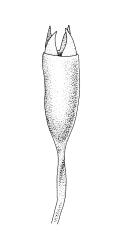Plants minute, green or brown, with persistent protonemal flaps surrounding very short (usually less than 1.0 mm) perichaetial buds or shoots. Conspicuous shoots and vegetative leaves absent.
Autoicous (perichaetial and perigonial buds arising from the same protonema). Perichaetial shoots brown, less than 1.0 mm, arising from a whorl of protonemal flaps. Perichaetial leaves with or without costa. Setae straight or weakly flexuose; capsules erect, ellipsoid, with rim undulate or not; exothecial cells oblong and ± incrassate; stomata reportedly present at capsule base. Peristome teeth four, triangular, consisting of multiple layers of dead but intact cells. Operculum high conic, acute. Calyptra completely enclosing the maturing capsule, becoming mitrate, divided into c. 6 narrow lobes c. ⅔ to apex.
A genus of 1 to 3 species, depending on taxonomic interpretation. The type species is apparently not designated. All species are largely restricted to mountainous areas of the northern hemisphere. One species is dramatically disjunct in N.Z.
| Category | Number |
|---|---|
| Indigenous (Non-endemic) | 1 |
| Total | 1 |




